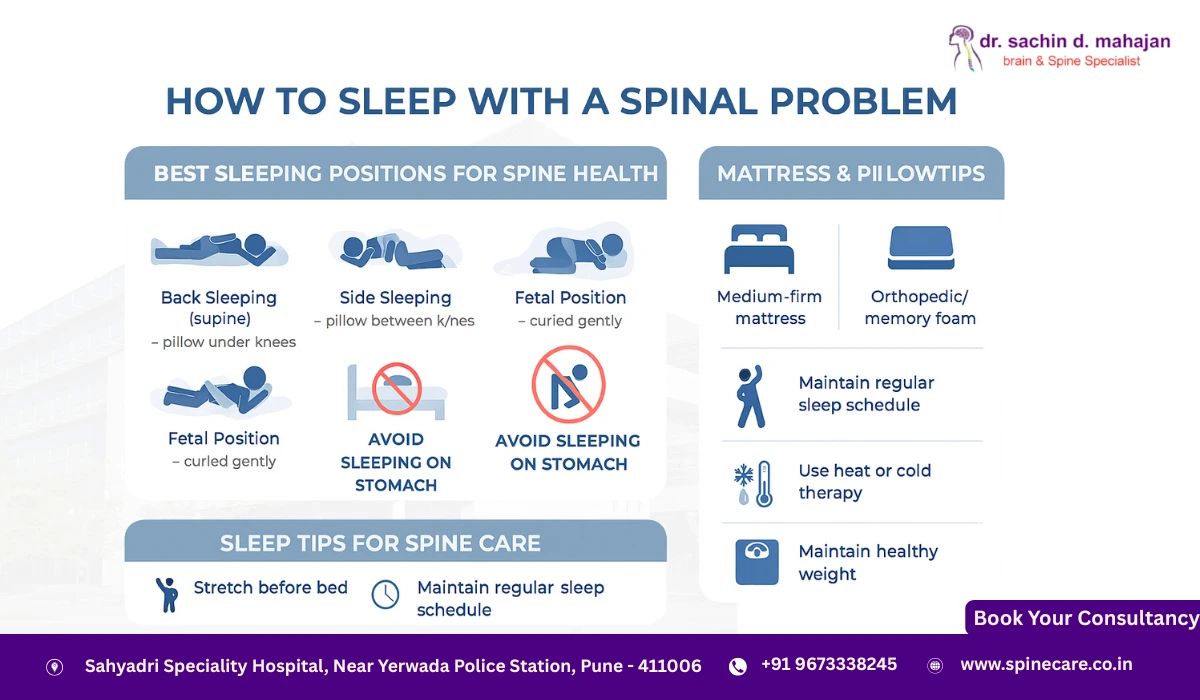
How to Sleep with a Spinal Problem: Best Sleeping Positions and Tips for Pain Relief
Sleep plays a vital role in healing and maintaining spinal health. However, for individuals struggling with back or spinal issues, getting a good night’s rest can be challenging. Pain, stiffness, and improper posture can worsen symptoms, making mornings more uncomfortable.
If you are living with chronic back pain, a herniated disc, sciatica, or any spinal disorder, your sleeping position and mattress choice can either alleviate or aggravate your symptoms. In this article, we will explore how to sleep with a spinal problem, including the best positions, sleep hygiene tips, and professional recommendations from a Spine Specialist in Pune.
How Are Sleep and Spinal Health Connected?
Your spine supports the entire body and allows movement, flexibility, and posture control. It consists of vertebrae, intervertebral discs, and surrounding muscles and ligaments. When this structure is affected—due to conditions like degenerative disc disease, slipped disc, sciatica, or spinal stenosis—even simple activities like lying down or turning during sleep can cause discomfort.
Poor sleeping habits can increase pressure on spinal discs, strain muscles, and disrupt spinal alignment. Conversely, proper sleep posture helps maintain the natural curvature of the spine, relax muscles, and promote healing.
What Are the Common Spinal Problems That Affect Sleep?
Several spinal disorders can make sleeping difficult. Understanding your condition helps you choose the best sleeping posture:
- Herniated or Slipped Disc:
Pain worsens when lying flat; certain positions may relieve pressure on nerves. - Sciatica:
Caused by irritation of the sciatic nerve; results in radiating pain down one leg. - Spinal Stenosis:
Narrowing of the spinal canal that compresses nerves, often leading to pain and numbness. - Scoliosis:
Abnormal curvature of the spine that makes finding a comfortable sleeping position difficult. - Degenerative Disc Disease:
Discs lose cushioning ability, leading to stiffness and pain, especially at night.
If any of these conditions are interfering with your rest, consult a spine specialist in Pune to identify the exact cause and get personalized advice.
What Are the Best Sleeping Positions for People with Spinal Problems?
Choosing the right sleeping position plays a vital role in keeping your spine properly aligned. Let’s explore how various sleeping positions impact spinal health:
1. Sleeping on Your Back (Supine Position)
- Best for: General spine alignment and pressure distribution.
- How to do it correctly:
- Use a small pillow under your knees to maintain the natural curve of your lower back.
- Use a supportive pillow under your head to align your neck with the spine.
- Avoid overly soft mattresses that let your hips sink in.
Why it helps:
This position keeps the spine, neck, and head aligned, minimizing stress on the back and reducing morning stiffness.
2. Sleeping on Your Side (Lateral Position)
- Best for: Sciatica, herniated disc, spinal arthritis, and pregnant individuals.
- How to do it correctly:
- Lie on your side with knees slightly bent (not curled tightly).
- Place a firm pillow between your knees to reduce hip and lower back strain.
- Use a pillow that fills the gap between your shoulder and neck.
Why it helps:
This position reduces nerve compression and maintains spinal alignment, especially if you use a pillow between the knees.
Tip: Try sleeping on your left side — it improves circulation and reduces acid reflux.
3. Sleeping in the Fetal Position
- Best for: Herniated discs or nerve compression.
- How to do it correctly:
- Lie on your side and gently curl your torso toward your knees.
- Avoid tucking in too tightly to prevent restricted breathing.
Why it helps:
This posture opens up the space between vertebrae, relieving pressure on nerve roots.
4. Sleeping on Your Stomach (Not Recommended)
- Why to avoid:
This position flattens the spine’s natural curve and strains the neck and lower back.
If you must sleep this way, place a thin pillow under your abdomen to support the lower spine and avoid neck twisting.
How to Choose the Right Mattress and Pillow for Spinal Support?
Your mattress and pillow play a major role in how well your spine rests during sleep.
Mattress Tips:
- Medium-firm mattress: Ideal for most spinal problems. It supports the spine without letting it sink.
- Memory foam or orthopedic mattress: Adjusts to your body shape, relieving pressure points.
- Avoid overly soft beds: They can cause spinal sagging and worsen pain.
Pillow Tips:
- Choose a pillow that maintains neck alignment with your spine.
- For back sleepers: A thinner pillow is better.
- For side sleepers: A thicker pillow that supports the space between shoulder and neck is ideal.
- For lower back pain: Try a small lumbar pillow or rolled towel under the back or knees.
If unsure which type to choose, seek guidance from a Spine Specialist in Pune who can suggest the most suitable support options.
Additional Sleep Hygiene Tips for Spine Problems?
Apart from your sleeping position and mattress, these daily habits can improve sleep quality:
1. Maintain a Regular Sleep Schedule
Go to bed and wake up at the same time daily to regulate your body clock and improve rest.
2. Gentle Stretching Before Bed
Light stretching or yoga helps loosen tight back muscles and reduces nighttime stiffness.
3. Use Heat or Cold Therapy
Applying a warm compress before bed relaxes muscles, while cold packs reduce inflammation.
4. Limit Screen Time
Blue light from phones and laptops interferes with melatonin production, disrupting sleep cycles.
5. Maintain a Healthy Weight
Excess body weight puts additional pressure on the spine, increasing pain and discomfort.
6. Consult a Professional
If sleep disturbance persists for more than a few weeks, consult a spine specialist. They can identify the underlying issue and suggest proper therapy or non-surgical treatments.
When Should You See a Spine Specialist in Pune?
You should consider visiting a Spine Specialist in Pune if you experience:
- Persistent back or neck pain that worsens at night
- Numbness or tingling in limbs
- Difficulty turning or moving during sleep
- Morning stiffness that lasts beyond 30 minutes
- Pain radiating to legs or arms
Early diagnosis helps prevent long-term spinal damage and restores comfortable, restful sleep.
Non-Surgical Ways to Improve Sleep and Spine Health?
Many people assume spine pain requires surgery, but non-surgical treatments can be highly effective. Options include:
- Physiotherapy: Strengthens core and back muscles, improving posture.
- Chiropractic care: Realigns the spine to relieve pressure.
- Medication: Pain relievers or muscle relaxants for short-term relief.
- Epidural injections: For reducing inflammation in severe cases.
- Lifestyle modifications: Ergonomic support, exercise, and weight management.
These conservative approaches, combined with correct sleeping posture, can significantly improve sleep quality and spinal comfort.
Final Thoughts
Sleep is an essential component of spine health and recovery. With the right posture, supportive bedding, and lifestyle adjustments, you can minimize discomfort and wake up refreshed.
If your pain continues despite trying these methods, it’s important to consult a Spine Specialist in Pune for personalized evaluation and treatment. Proper medical care, along with consistent self-care practices, ensures better spine health and quality sleep for years to come.
Call to Action
If you’re struggling with sleep due to a spinal issue, don’t ignore the signs.
Visit SpineCare Clinic, Pune to consult an experienced Spine Specialist in Pune and find the right treatment for lasting relief.
Read Here: Common Spine Problems: Causes, Symptoms, and Treatment Options You Should Know




